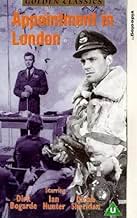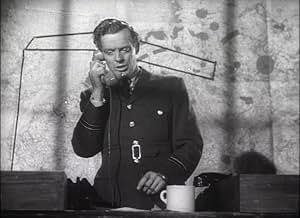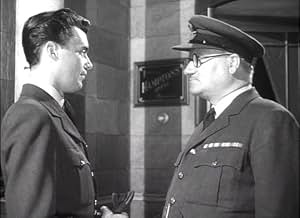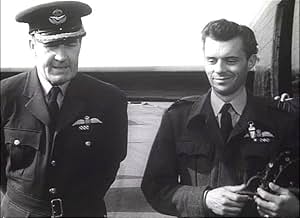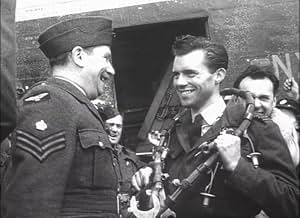Agrega una trama en tu idiomaWar drama about the dangerous and stressful work of Lancaster bomber British crews during World War II.War drama about the dangerous and stressful work of Lancaster bomber British crews during World War II.War drama about the dangerous and stressful work of Lancaster bomber British crews during World War II.
- Dirección
- Guionistas
- Elenco
Opiniones destacadas
Some of the best war films have been movies about the Allied bombing campaign of WWII. "Command Decision", "12 O'Clock High" and "Raiders in the Sky" are all excellent films--though the latter is set at a British bomber base whereas the first two are about American bases. While I wouldn't quite put this film in the same level as the other two in quality, it is awfully close and well worth your time.
The film centers around Wing Commander Mason (Dirk Bogarde). He's a very good pilot. However, his 87 missions is wearing on him and he's long overdue to be retired from the front line. Oddly, instead of being happy about this, Mason insists on being able to at least reach 90...and then he'll quit. The film is a nice portrait of Lancaster pilots and crew and because it was made not too long after the war, the filmmakers were able to use three airworthy bombers--which added to the realism.
So why do I think this one isn't quite up to the level of the American films? Well, mostly because Mason just seems to take the whole thing in stride (apart from insomnia) and he seems amazingly well adjusted...taking away from the tension that DID come because the other two films focused so strongly on the emotional toll. Still, a nice tribute to these brave men and well worth your time.
The film centers around Wing Commander Mason (Dirk Bogarde). He's a very good pilot. However, his 87 missions is wearing on him and he's long overdue to be retired from the front line. Oddly, instead of being happy about this, Mason insists on being able to at least reach 90...and then he'll quit. The film is a nice portrait of Lancaster pilots and crew and because it was made not too long after the war, the filmmakers were able to use three airworthy bombers--which added to the realism.
So why do I think this one isn't quite up to the level of the American films? Well, mostly because Mason just seems to take the whole thing in stride (apart from insomnia) and he seems amazingly well adjusted...taking away from the tension that DID come because the other two films focused so strongly on the emotional toll. Still, a nice tribute to these brave men and well worth your time.
I had seen this film when I was in school where it was shown as part of educational films screened by one of my schoolmasters who had himself served in the Royal Indian Air Force in Burma.Today I own a copy on DVD. The exploits of people in Bomber Command is brought out with extreme accuracy to the screen by creating an atmosphere that is taut and realistic. Dirk Bogarde gives one of his best performances as the Wing Commander who is definitely cracking under the stress of command but does not want to accept it. The scenes where he gives Bryan Forbes a dressing down will certainly strike a chord where his sense of responsibility to the team is exposed. The accuracy of operations of RAF Bombers during night sorties right from the point of take off, to the tension of the ground staff till their return is brilliantly photographed. There are no clichés or extended heroics quite common in similar films but dark realism of survival during the war with the atmosphere of the airfields and aircrew intact. Being the son of an Air Force officer who did some war service in India the realism is striking. I would certainly recommend it to the younger viewers who need to study such situations.
This is probably the most realistic drama filmed about Bomber Command late in WWII. The technical details are superb.. the right aircraft in the right locations with the correct props and background.
The acting really is first class and if it seems a little stilted then that's how it was then... if you don't believe me watch "Target for Tonight" which covered a Wellington Bomber mission early in the war and used real RAF crews .
There are no over the top heroics, but the mood is just right, with a constant tension even in moments of relaxation... the war had become a relentless exercise in mechanised killing with operational crews knowing that the chances of them living to complete a full tour of 30 operations was one in four at best, but they just got on with it. far better than "The Dam Busters".
The acting really is first class and if it seems a little stilted then that's how it was then... if you don't believe me watch "Target for Tonight" which covered a Wellington Bomber mission early in the war and used real RAF crews .
There are no over the top heroics, but the mood is just right, with a constant tension even in moments of relaxation... the war had become a relentless exercise in mechanised killing with operational crews knowing that the chances of them living to complete a full tour of 30 operations was one in four at best, but they just got on with it. far better than "The Dam Busters".
This is an unusual film. As others have commented it is well made, tautly scripted and has very good central performances. But that isn't what singles it out.
It's commonly thought that night time area bombing by the RAF was a hit or miss affair, quite different from daylight precision bombing done by the USAAF. Whilst no one can argue that targets were easier to see during daylight hours, both the RAF and the Luftwaffe developed highly accurate methods of hitting their targets at night. In the fateful Dresden raid in February 1945, almost 95% of the RAF bombload fell within one mile of the markers placed with 50 metre accuracy by the Mosquito target illuminator aircraft. The following day, a quarter of the American daylight force sent to follow up bombed Prague, having mistaken one bend in the River Elbe for another.
This film depicts, at length, the method of target marking the flight path using coloured airburst flares, eliminating 'creepback' by approaching the target along different vectors, air and ground marking the target and using a 'Master Bomber' to control the incoming streams and give bomb aimers feedback on accuracy.
No medal was struck for Bomber Command and many of the crew themselves felt their contribution was best forgotten, so this film is one of the few accurate testaments to their courage.
It's commonly thought that night time area bombing by the RAF was a hit or miss affair, quite different from daylight precision bombing done by the USAAF. Whilst no one can argue that targets were easier to see during daylight hours, both the RAF and the Luftwaffe developed highly accurate methods of hitting their targets at night. In the fateful Dresden raid in February 1945, almost 95% of the RAF bombload fell within one mile of the markers placed with 50 metre accuracy by the Mosquito target illuminator aircraft. The following day, a quarter of the American daylight force sent to follow up bombed Prague, having mistaken one bend in the River Elbe for another.
This film depicts, at length, the method of target marking the flight path using coloured airburst flares, eliminating 'creepback' by approaching the target along different vectors, air and ground marking the target and using a 'Master Bomber' to control the incoming streams and give bomb aimers feedback on accuracy.
No medal was struck for Bomber Command and many of the crew themselves felt their contribution was best forgotten, so this film is one of the few accurate testaments to their courage.
It has something of an inauspicious title, in that it doesn't do justice to the film making craft and subject matter on offer here in Phillip Leacock's film.
Leacock and his lead man, the splendidly regal Dirk Bogarde, produce a war film of undoubted human depth. There's no sledge hammer tactics to try and curry favour with the critics and film goers alike, no clichés bogging the narrative down, this is an honest to goodness telling of the emotional trials, strains, fears and peeves of a Bomber Command Squadron in England preparing for a mission during WWII 1943. Even the inevitable romantic threads are handled with skill by the makers, never cloying and adding impact as the heroes get ready for the big bully off.
Some of the action sequences show their age, but that's fine in the context of old time cinema, while the likes of Twelve O'Clock High (which came four years before this was released) set the bar too high for Leacock's film to be unfairly compared with. Yet this earns its stripes, very much so, because as those wonderful Avro Lancaster's take to the skies and thunder though the clouds, you realise you care about every single one of those involved in the mission, both in the air and on the ground. 7.5/10
Leacock and his lead man, the splendidly regal Dirk Bogarde, produce a war film of undoubted human depth. There's no sledge hammer tactics to try and curry favour with the critics and film goers alike, no clichés bogging the narrative down, this is an honest to goodness telling of the emotional trials, strains, fears and peeves of a Bomber Command Squadron in England preparing for a mission during WWII 1943. Even the inevitable romantic threads are handled with skill by the makers, never cloying and adding impact as the heroes get ready for the big bully off.
Some of the action sequences show their age, but that's fine in the context of old time cinema, while the likes of Twelve O'Clock High (which came four years before this was released) set the bar too high for Leacock's film to be unfairly compared with. Yet this earns its stripes, very much so, because as those wonderful Avro Lancaster's take to the skies and thunder though the clouds, you realise you care about every single one of those involved in the mission, both in the air and on the ground. 7.5/10
¿Sabías que…?
- TriviaThis movie was filmed at R.A.F. Upwood. The Lancasters used were NX673, NX679, and NX782. These aircraft also took part in the filming of The Dam Busters (1955).
- ErroresIn the scene depicting the take off starring Bill Kerr as the Australian pilot, he starts the aircraft up with the phrase "contact port outer". This is incorrect - the Lancaster would have started with the port inner engine as this drove the hydraulics which controlled the turrets etc.
- Créditos curiososClosing credits epilogue: This story is humbly dedicated to all those airmen who were unable to keep an Appointment in London
- ConexionesFeatured in Into the Wind (2011)
Selecciones populares
Inicia sesión para calificar y agrega a la lista de videos para obtener recomendaciones personalizadas
- How long is Raiders in the Sky?Con tecnología de Alexa
Detalles
- Tiempo de ejecución1 hora 36 minutos
- Color
- Relación de aspecto
- 1.37 : 1
Contribuir a esta página
Sugiere una edición o agrega el contenido que falta

Principales brechas de datos
By what name was Appointment in London (1953) officially released in India in English?
Responda
